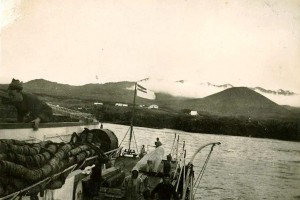On 12 April 1950 the H.M.S.A.S. Natal sailed south from Durban under the captaincy of Lieutenant Commander Merddyn Ray Terry-Lloyd (29 July 1913 – 28 October 1978) to undertake what was then called the Fourth Marion Island Relief. Aboard were members of the Fifth Marion Team (M5) led by Team Leader and Meteorologist Daan Triegaardt, along with 12 sheep for the island. The frigate returned with members of M4 (led by Meteorologist Hennie van den Boogaard) to Durban via East London, docking on 28 April.


Keith Durno of East London was an 18-year-old member of the naval crew aboard the frigate and in 2012 he sent the following account to Professor Werner Nel (Department of Geography and Environmental Science, University of Fort Hare) who passed it along to the Antarctic Legacy of South Africa project. After ALSA made direct contact with him, Keith sent the photographs mentioned in his account for archiving. Some of these photos are shown here.
“It is 62 years* since I went to Marion Island so I will give you as much as I remember. I started my naval training in June 1948 and went for basic training to Salisbury Island [Durban] in 1949. In 1950 we were told that for our two weeks sea training we would be going to Marion Island to take supplies. At that time all we knew of Marion was that it had been annexed by South Africa.
On 13 April we reported to the Port Rex Base in East London and were issued with our hammocks and later went down to the harbour and boarded the H.M.S.A.S. Natal. There we were issued with flying suits (Kapok? lined), inner and also the outer suit, duffel coat, fur-lined boots and stocking cap.
We sailed that afternoon (13 April 1950) and were all sent to the main seamen’s mess deck but there were too many of us so they sent the miscellaneous division (writers, telegraphists and signallers) to the for’ard mess deck, right in the bows of the ship, just aft of the cable locker. It turned out to be a good move as we were very [well] looked after by the permanent force men.
The voyage down was without incident and we arrived early on the 17th April. We thought it was freezing and had all our “arctic” clothes on. There was a thick mist and we could hear the sound of an outboard motor when, out of the mist appeared an inflatable and the men were not dressed for icy weather. We assumed they had become acclimatised



That first day I went ashore with the shore party at Transvaal Cove where we were assigned duty of landing stores. The ship’s boat came alongside the landing stage which was floating on 44-gallon drums and was also supported by cables from the top of the cliff so the jetty could [be] winched up or down depending on the tide. We had also brought timber for building and this was towed behind the boat and landed through the surf. There were also 10 or 12 sheep which were landed. A like control number of sheep [was] kept in S.A. so comparisons could be made as to the growth of wool and, I presume, other things.

The second day we worked on board, loading the boat. The wind came up and a signal was sent to the shore party that the ship would have up-anchor as the anchorage was unprotected. Two of our group were left behind and has to spend the night ashore. Apparently they were spoiled rotten.
The following day we went across to Prince Edward Island to do the annual hoisting of the S.A. flag to confirm our claim to the island. The flag was in a cave to protect it from the strong winds. From there we returned to East London.
I have a number of photographs, some general scenes but one that appeared in the local newspaper of the landing stage showing a sling of stores being hoisted up the cliff.”
*Written in 2012.
With thanks to Keith Durno, his daughter, Elizabeth and Werner Nel. Keith passed away in May 2014. R.I.P.
Featured photograph: Keith Durno on the H.M.S.A.S. Natal, Cave Bay, Prince Edward Island, 20 April 1950
Reference:
Terry-Lloyd, M.R. 1950. Report of Proceedings: Fourth Marion Island Relief 12th April to 28th April, 1950. Pretoria: South African National Defence Force Documentation Centre. N.2/3/2. 13 pp.
John Cooper, Principal Investigator, Antarctic Legacy of South Africa, Department of Botany and Zoology, Stellenbosch University, 10 January 2016

